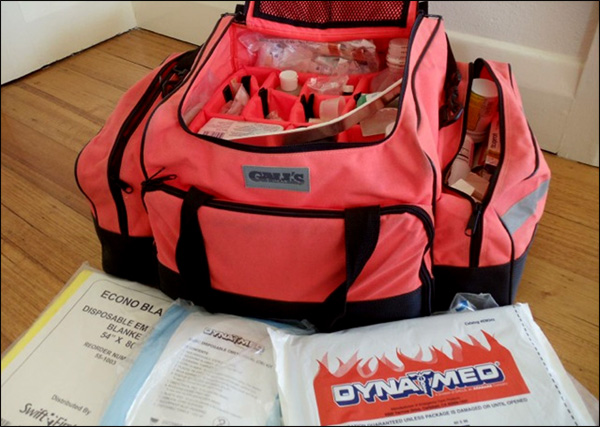 |
Under the guise of a routine checkup, I set up an appointment to see our doctor before we quit our jobs and lost our medical benefits.
I didn’t need the doctor to check me out; I wanted her to check out my list of First Aid supplies for our boat. Paul and I were going to sail around the world and I had no idea what medical emergencies we might face.
Dr. Smith smiled when I confessed the real reason for my visit. A sailor herself, she gamely reviewed my list, took some notes and then handed me a catalogue of first aid kits for Emergency Medical Technicians. She suggested that I order one of these First Aid kits as they were more complete than the average camping kit. She also asked me to return in a week, with my husband, two oranges and 2 pigs’ feet.
A week later, during her lunch hour, she taught Paul and I how to give the orange injections. Apparently injecting an orange, with its tough outer peel and soft interior, was similar to giving a person a shot. Then she made slits in the pigs’ feet and showed us how to sew basic sutures before passing the feet to us to stitch up. I was surprised at how rubbery and impenetrable the skin was, and each haphazard stitch I made marked my struggle. Paul’s stitches, on the other hand, were evenly spaced and neatly done.
When Paul saw my needlework, he exclaimed, “I hope I don’t need any stitches!“ Then Dr. Smith pulled out her pen and pad and wrote us eight prescriptions, mainly for broad-spectrum antibiotics and eye/ear ointments. She also recommended two books we should have on board: The Merck Manual of Medical Information (Home Edition) and the PDR Nurse’s Drug Handbook.
When our First Aid kit arrived, I examined it before adding our prescription medicine to the huge fluorescent bag. Then I headed to Walmart for an “over-the-counter” shopping spree, stocking up on items that we currently used, such as Blistex, antacid tablets, Advil, hydrocortisone cream, Benadryl, and Bandaids. I also purchased seasickness tablets, in various formulations. This completed our kit.
We seldom needed our well-stocked First Aid kit during our four-year cruise, which took us from Charleston, SC, to New Zealand and then north to Micronesia and finally back to San Francisco. A little squirt of Bactine and an ordinary bandage took care of most of our injuries.
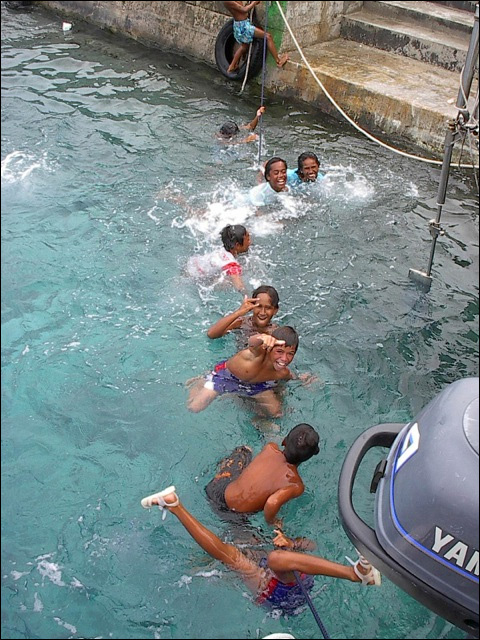 |
| Here, the Katiu Kids as we called them swing on our mooring line. We believe Paul punctured his arm on the chain link fence that is attached to this concrete sea wall while goofing off with the children. |
That is until we reached Katiu, an atoll in the Tuamotu Archipelago.
Paul somehow punctured his arm on a rusty chain link fence. I applied my usual Bactine and Bandaid therapy to his small dot-like wound and figured I had fixed the problem.
A couple of days later, as we were sailing to another atoll 35 miles away, Paul complained that his arm felt numb. And the numb feeling was spreading into his hand and shoulder.
Through satellite e-mail, I set up a SSB radio call to our friends on another boat a hundred miles away; the wife was a nurse. Over the radio, she asked what antibiotics we had on board. I pulled out our list and read them to her; she whistled in admiration when she learned how well-equipped we were.
Thank you Dr. Smith! Our nurse friend put Paul on a course of penicillin and days later, his infection was gone.
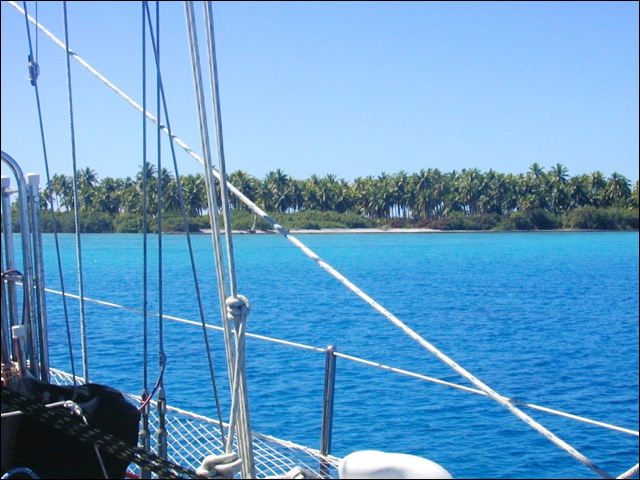 |
| Tahanea, the atoll we were sailing to when Paul’s arm became numb, is uninhabited. Thank goodness for cruising nurses! |
Two more years passed before we needed our First Aid kit again.
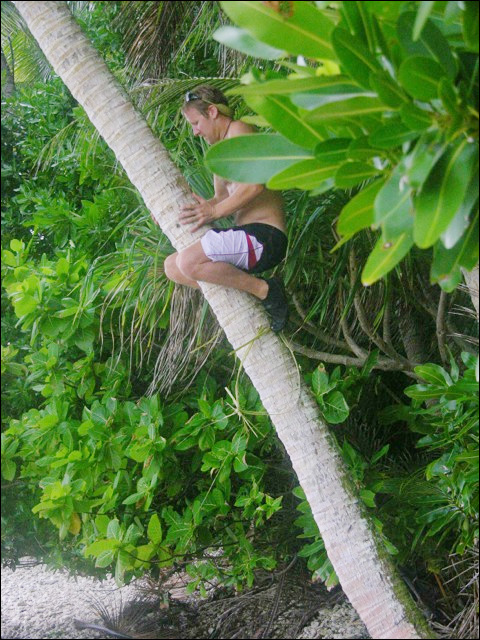 |
| This is the coconut tree that Paul climbed, where he got bitten by mosquitoes carrying Dengue Fever. |
In Abaiang, an atoll in Kiribati, Paul got bit by dozens of mosquitos while climbing a coconut tree at dusk. When he returned to the boat, he was so proud of the coconuts that he neglected to mention the mosquitos.
Days later, I found him kowtowing on our bed in pain, rocking himself and begging me to turn off the lights (which weren’t on). I suddenly realized the downside of being off the “beaten path:” there were no friends to call over the radio. Due to interference, we were too far away even for the SSB sailing nets.
I consulted our Merck Manual and thought he had the symptoms of a sinus infection; Paul had been spearfishing in Abaiang and he liked to dive deep. But the course of antibiotics I prescribed to him did nothing to alleviate his pain; on the contrary, it seemed to be increasing. He also developed a high fever.
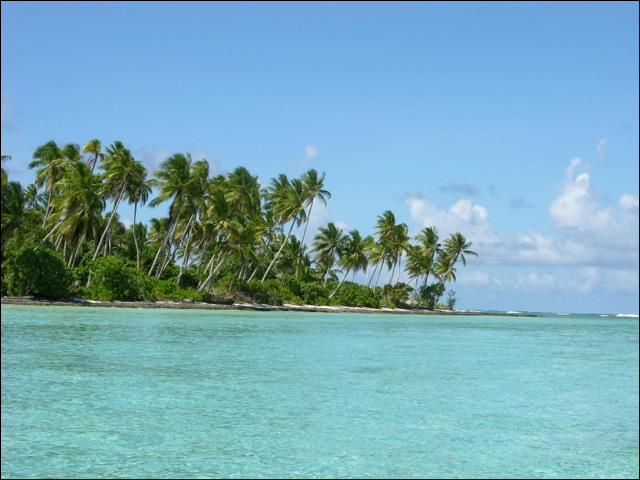 |
| This is the anchorage in Abaiang. |
Thankfully, we had sailed back to Tarawa, the capital of Kiribati, before his symptoms appeared. So I dinghied ashore and phoned one of the island’s doctors who concluded that he must have gotten Dengue Fever. She said I could bring him to the hospital to stay but there was nothing they could do for him.
I opted to keep him on board, where we had safe drinking water, a gentle breeze that kept away the mosquitoes and a mattress on our bed. Trying to lower Paul’s high fever in the equatorial heat was not easy but I spritzed him – often! – with a water bottle which caused my husband to moan even more. Days later, the pain became intolerable. I reached into our large First Aid kit and pulled out the strongest pain relief medicine we had onboard. It was a narcotic nasal spray that gave him temporary relief and, once again, I was thankful for Dr. Smith’s foresight.
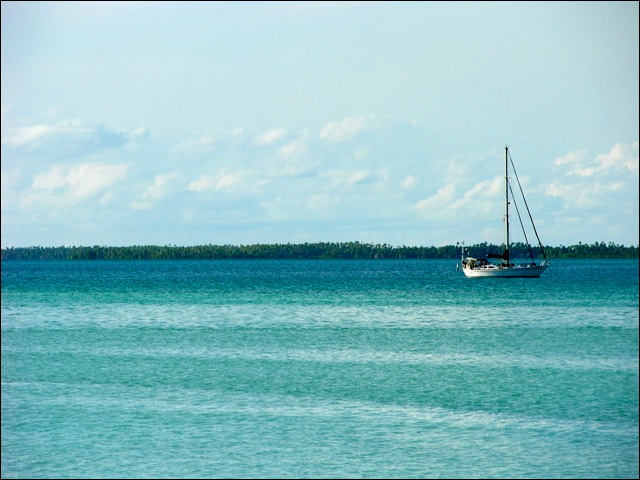 |
| We were the only yacht in Tarawa, the capital of Kiribati, so when Paul contracted Dengue Fever, there were no other cruisers around to help. |
It took weeks for Paul to fully recover from his bout with Dengue and while he was ill, I played nurse and Captain. We were anchored off of Betio, and whenever the trade winds shifted – as they frequently did that January – land became a lee shore. Shipwrecked fishing boats littered the coral reef behind our boat and I was forced to maintain anchor watches. That was in addition to the daily maintenance of living on a boat: charging the batteries, running the fridge/freezer, making water during an incoming tide, checking the snubber, and stowing items whenever the boat started bouncing around.
When I wasn’t tending to Paul or to the boat, I was looking after newest crew member: a 2-month old I-Kiribati baby whom we were in the process of adopting. So, in my “free time,” I washed diapers, sterilized bottles, fed and played with our beautiful daughter.
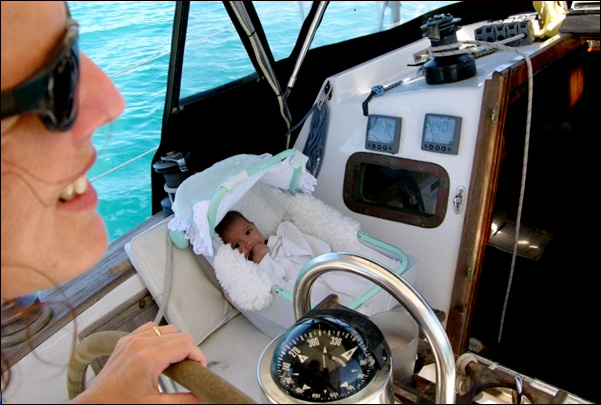 |
| I steer our 42-foot Tayana sailboat, Cherokee Rose, out of Tarawa’s lagoon while our newest crew member, Jessica, watches. We were excited to be sailing to Abaiang, not knowing what lay ahead… |
I felt overwhelmed. Then I realized how lucky I was: at least we were anchored at an atoll that had doctors and a small hospital. Imagine if his symptoms had appeared while we were on passage? How would I have coped? Would I have reefed the sails, heaved-to, returned to our last port or carried on? Paul and I had never considered this scenario. But, if there is one thing that cruising has taught me, it is this: I am capable. Somehow, I would have managed.
Here are my tips for First Aid Afloat:
- Take a couple of First Aid classes before you leave shore, and bring your textbook(s) on board for reference.
- Try to find a doctor with sailing experience to advise you on your First Aid kit. Ask around at your marina; ask your sailing buddies. Or talk to your usual doctor, but explain that you might be 20 days from land when a medical emergency arises so you – and your First Aid kit – need to be prepared.
- Buy a well-stocked First Aid kit as your primary one; buy a compact one for your grab bag, in case you have to suddenly abandon ship.
- Purchase the latest editions of the The Merck Manual of Medical Information: 2nd Home Edition
as well as the PDR Nurse’s Drug Handbook.
Both are invaluable. The latter one contains useful information about prescribing medicine that is not included on the prescription label; the Merck Manual (Home Edition) uses terms that a normal person can understand.The third most-consulted book I had aboard is Where There Is No Doctor: a village health care handbook
by David Werner with Carol Thuman and Jane Maxwell (and published by the Hesperian Foundation). This gem offers basic first aid techniques using limited help and supplies.
- Consider how you might handle a medical emergency at sea or at anchor, with cruisers nearby or on your own. Make a plan. Hopefully you will never need it.
About Kelly Watts
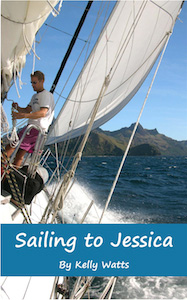 |
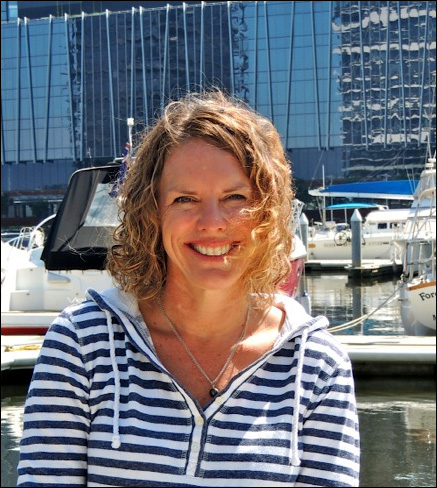 |
Kelly Watts is the author of Sailing to Jessicaan account of her and her husband’s 4-year sailing adventure that took them halfway around the world…and lead them to their baby daughter on a remote Pacific Island.
Tania Aebi, author of Maiden Voyage, said “The details of Paul and Kelly’s journey will bring the reader aboard the roller coaster ups and downs of the cruising life, the seemingly endless frustrations mitigated by unforgettable friendships, joy and awe that make it all so worthwhile, an experience of a lifetime. Here is an inspirational couple who recognized an opening in their lives and seized a moment leading to the kinds of memories that only a life at sea can bring . . .”
After enduring a gale at anchor and nearly losing their lives, with baby Jessica on board, Kelly and Paul decided to return to life-on-land but the cruising spirit has never left them. They and their two children have lived in the United States, India and now reside in Australia.
Prior to writing her book, Kelly has produced and/or written articles for national magazines such as Blue Water Sailing, Better Homes and Gardens and Hometown Cooking. She also had a weekly food column for the Milwaukee Journal Sentinel and the St Paul Pioneer Press for several years. For more information, visit the Sailing to Jessica website www.sailingtojessica.com.
Sailing to Jessica is available on amazon.com (paper and Kindle edition) and iTunes.
Here is the book trailer:
- The need to know (Admirals’ Angle column #17):Suddenly alone: A true story illustrating why women on boats need to have the skills and attitude to meet challenges
- Heath & Medical: Women & Cruising Resources
- Medical books recommended by Women & Cruising (from the Women & Cruising Bookstore – Reference Books)
More from the web
- The Merck Manual of Medical Information: 2nd Home Edition
- PDR Nurse’s Drug Handbook 2013
- Where There Is No Doctor: a village health care handbook
, by David Werner with Carol Thuman and Jane Maxwell

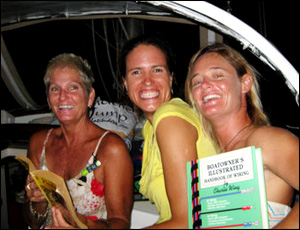
Great article! Access to medical care is something we always worry about when cruising in the Bahamas. This past winter my husband got an infection from a cut on his hand. Luckily, we were still in the US. It took almost 4 months before he was fully cured. The hand surgeon in Savannah was a boater so I asked him what we should have on board for emergencies. He gave us a prescription for Epi pens and also said we should have a product called Medihoney. It’s an over-the-counter product used to help heal wounds faster. It turned out that the infection was a weird marine kind that only responds to certain antibiotics. Lesson learned was to never ignore a cut that doesn’t heal normally!
We, too, were very fortunate that our primary physician is well acquainted with travelers. As long as we had a meeting/exam with him once a year, he was willing to keep our first aid/med kit well stocked. In addition to several antibiotics, pain meds, seasickness medicine, allergy meds, we also had silvadene crème and other specific needs meds. He was willing to have us contact him by phone or email for advice.
We had several books, medical guides, PDR, hazardous marine life books, a large first aid kit, and superglue, as an alternative to stitches in heavy seas. We were both DAN certified O2 providers, and carried oxygen with a positive demand regulator.
I would strongly recommend that cruisers look into DAN (Diver’s Alert Network) insurance. It offers Air Assist in case evacuation is needed, and is very reasonably price.